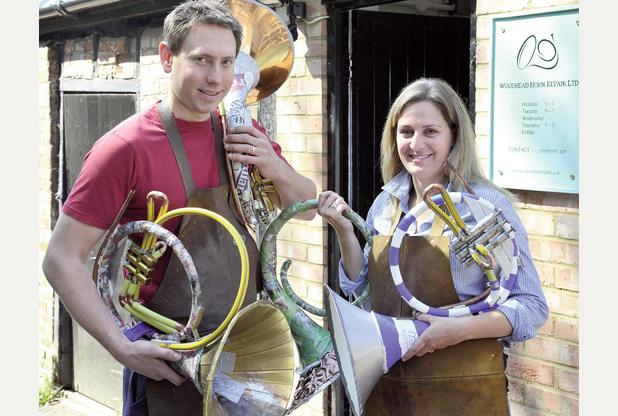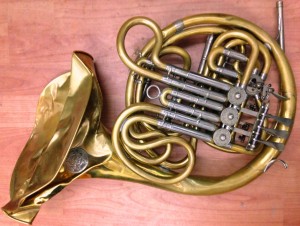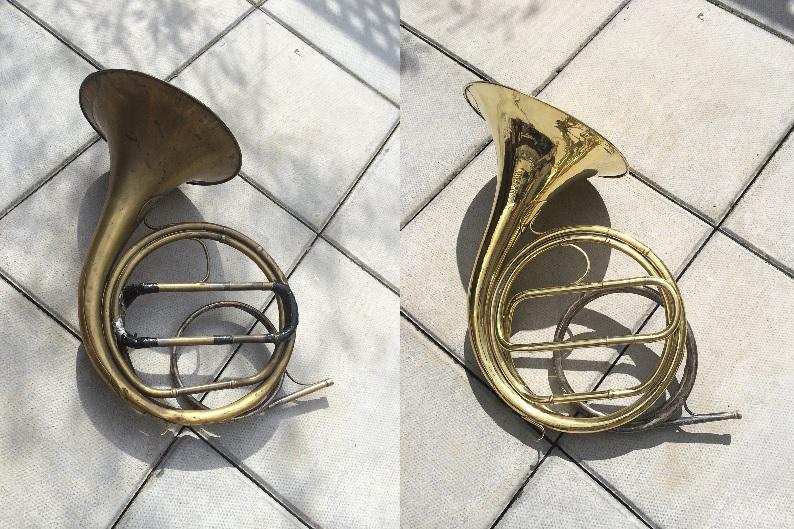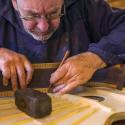A few years ago I wrote a book about the French horn which was made into a stage play. The play had a minimal set design, so we decided to hang some horns from the lighting rig over the playing area. To do this we needed about a dozen instruments. I borrowed a couple, threw in my own, and we also bought a quartet of knackered old instruments. Collectively they looked splendid as a carefully lit constellation of coils and flared bells dangling from the ceiling.
 When the play finished the horns dispersed. All apart from one. It was a hand horn (aka a natural horn) – that is, it had no valves for changing the length of tubing through which the air travels, and thus altering the key. It was the sort of prelapsarian instrument for which Mozart and Beethoven composed, the likes of which are nowadays played by period specialists and no one else.
When the play finished the horns dispersed. All apart from one. It was a hand horn (aka a natural horn) – that is, it had no valves for changing the length of tubing through which the air travels, and thus altering the key. It was the sort of prelapsarian instrument for which Mozart and Beethoven composed, the likes of which are nowadays played by period specialists and no one else.
Mine was a brute. Sections of the tubing were wrapped in gaffer tape. There were dents all over. And the lacquer had long since worn off. It looked muddy. It also sounded it. I stuck it on a high shelf and forgot about it. Then, when moving house recently, the time arrived either to get rid of it or ask it to justify its retention. I plumped for the latter. It was going to need some professional TLC.
The best place I know of to get your horn sorted is Woodhead Horns. The surname belongs to Luke and his Australian wife Heidi (pictured above). They met in the workshop of Paxman Musical Instruments, the main UK outlet for French horns, and set up on their own in 2007. I forwarded photographs to Luke of the offending instrument and the ensuing phone call was not full of promise. It’s dirty, it’s cheap, it’s old, and the metal is likely to be suffering from extreme fatigue, he advised. I sent the horn on ahead anyway, instructing him to do what he could.
Metal, lest we forget, is far more prone to environmental damage than wood, which is why the famous stringed instruments from Northern Italy last a great deal longerThere’s an upturned horn hanging on the wall outside their workshop down an alley in the pleasant town of Ampthill in Bedfordshire. Out of the bell a cluster of flowers are growing. It’s one use for an old natural horn, but I am determined to rescue my hand horn from ornamental retirement. The workshop consists of an office, a corridor leading to a workshop, and a secret room behind a closed door where, it turns out, alchemy is performed. There are horn bells and horn cases and horn tubing filling every cranny. They also cater for trumpeters and trombonists. My horn is on the bench in an advanced state of disassembly.
Luke shows me the bell where the maker’s mark is just about legible. Boosey & Son, it says. That dates it to before 1927, when the company merged to become the manufacturing and publishing behemoth Boosey & Hawkes. Luke thinks it looks like an old bandsman’s instrument which might have done service in the Great War. It’s certainly carrying the odd war wound. He points to the coiled tubing which is riddled with cracks. Metal, lest we forget, is far more prone to environmental damage than wood, which is why the famous stringed instruments from Northern Italy last a great deal longer. Hence the gaffer tape. When Luke removes it he discovers worse underneath: Blu-tak.
Watch Luke demonstrating the art of the dent ball:
“The problem is it’s full of holes,” advises Luke. “On an old instrument are like this some of the holes are because it’s been loved and cherished.” Is that a euphemism for smashed about, I ask him. “It is.”
There are four main jobs that need doing: (1) patching; (2) replacing; (3) de-denting; (4) polishing. By the time I arrive Luke has already starting on (2). He has removed the tuning slide and made a new one. I’m slightly agog that this can be done so easily. Luckily, another length of tubing also needs replacing, so he can show me how it’s done. This one’s trickier as it bends in two planes. Luke has a selection of long straight tubing stacked in a corner. He has selected one with the correct bore and cut it off the length he needs on a bandsaw.
Then on a flat bench he wedges the tube into a slot between the bench end and a metal stud he calls an iron (“it hasn’t really got a name”) and starts to bend (see video). First he achieves the rough shape he needs in one plane, then introduces the bend in the second plane. All the way through he’s comparing the tube to the discarded original.
How does a flimsy bit of brass not snap in two with all this pummelling? Simple. It’s been pre-filled with a lead compound called wood’s metal or MCP70. It’s much safer than lead, explains Luke, as it doesn’t explode on impact with water, and it also melts at a lower temperature. Once he’s got the shape he needs, he drops the tubing into a vast saucepan where water is boiling on the job. MCP70 melts at 70 degrees, and after a minute or so a silvery liquid can be seen slipping out of the tube and into the water, hollowing out the tube [see video].
The next job is to attach the tube to the rest of the horn, done with a bit more bending and then soldering. There’s a lot of blowtorch action in a modern brass workshop. Luke wields it like an electrical toothbrush. It’s especially helpful when patching holes. These have occurred because the original tube was created by folding a piece of sheet metal into a cylinder, which means it has a soldered seam along its whole length.
 “Generally the seam doesn’t last as well as the rest of the tube,” says Luke. He also explains that brass, being an alloy of copper and zinc, is prone to what’s known in America as redrot, or dezincification. “The acid in your body or the atmosphere will attack the zinc, which gets washed away with the water that you’re draining through it. [By water, for the information of non-brass players, he means the saliva generated when you blow through the mouthpiece.]
“Generally the seam doesn’t last as well as the rest of the tube,” says Luke. He also explains that brass, being an alloy of copper and zinc, is prone to what’s known in America as redrot, or dezincification. “The acid in your body or the atmosphere will attack the zinc, which gets washed away with the water that you’re draining through it. [By water, for the information of non-brass players, he means the saliva generated when you blow through the mouthpiece.]
The alloy separates and you’re left with the copper, which doesn’t last as long: it turns into holes and you get a colander.” To repair a hole Luke cuts out a thin sheet of shiny brass into delicate diamond shape and blowtorches it fast. This happens twice, both in places where Luke deems the horn to have been dropped. “It’s hit the floor too many times,” he says.
The leaks have now all been blocked but the horn still looks unsightly owing to the dense map of dents. Luke starts with the bell, slotting it onto what’s called a bell mandrel, a heavy pointed piece of iron fixed to a worktop. Holding the dented surface of the bell over the mandrel, Luke delicately smears the dents away in a technique known as burnishing. Magically the blemishes vanish.
The real pièce de résistance – and most time-consuming task – comes with the dents in the tubing. The only way to get rid of them is by running a metal pellet down into the tubing and aligning it precisely with the dent, then lightly tapping out the blemish with a ball-ended mallet known as a planishing hammer. How to get the right pellet? Luke has a vast wooden tray of dent balls of varying circumference to choose from. It’s a case of trial and error until he alights on the right one.
To ensure that the rugby-shaped ball goes all the way down and comes back again, Luke send it down with two other balls. A larger one acts like a hammer knocking it along the circle of tubing till it gets wedged against the dent so that the plenishing can be done. With copious shaking, the smaller one then dislodges it so it can be rolled out again. My horn calls for 90 minutes of dent removal, most of it taken up by rolling dent balls in and out. It’s intoxicating to watch Luke forcefully rolling and shaking the horn to jig the balls into position. (I have a go at it and I don’t remotely find the rhythm.)
Brass makers have been doing the same thing for the best part of 300 yearsAnd now for the linishing touch. No that’s not a typo. The horn is almost ready. I play it and the muddy sound has gone. The muddy look hasn’t. Luke takes the horn into the secret lair along the corridor and flicks the switch on a motorised belt known as a linisher. A long piece of rotating sandpaper whirs at high speed. He has already roughly resurfaced the new bit of tubing with this, and now he attaches a calico mop to the polishing wheel smeared with animal fat holding a light grit. He holds a section of the bell to the mop and the dull matt finish starts to sheen up. After a while he switches to a swansdown mop made of soft cotton and raises the horn bell to a final dazzling shine.
The result, when I take delivery of the finished article, is an astonishing facelift. What’s remarkable about the rejuvenation of my horn is that almost all the techniques, and much of the equipment, belongs to another century. Brass makers have been doing the same thing for the best part of 300 years. Mechanisation and electricity has speeded up the process, but the principles are the same. He shows me an illustration from a book showing a master trumpet-maker in Regensburg in 1698. In a game of spot the difference, there wouldn’t be much to go on. It’s just slower. I ask Luke how long it would have taken to polish the instrument up without the polishing machine. “Most of a day!”
Woodhead Horns Ltd, The Old Sorting Office, 17A Church Street, Ampthill, Bedfordshire, MK45 2PL (+44 7970 971520). www.woodheadhorns.co.uk. The company also works from Dots Music in Camden Town for two days at a week















Add comment